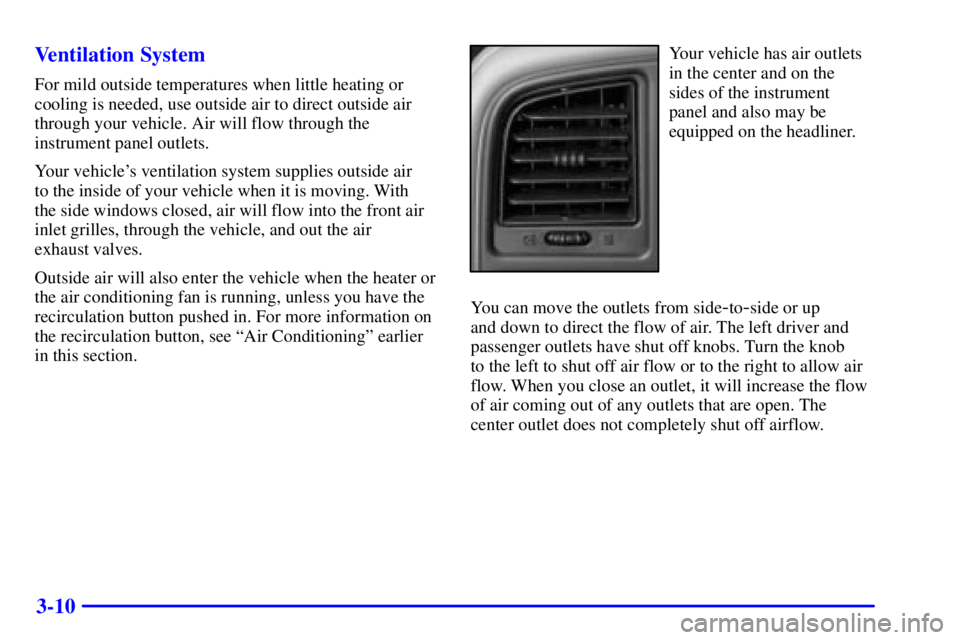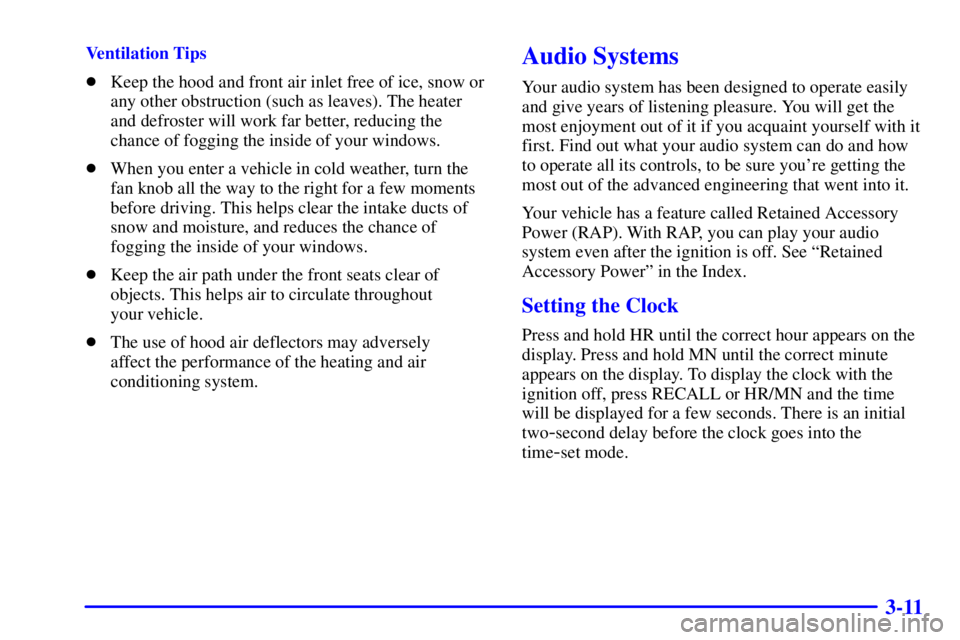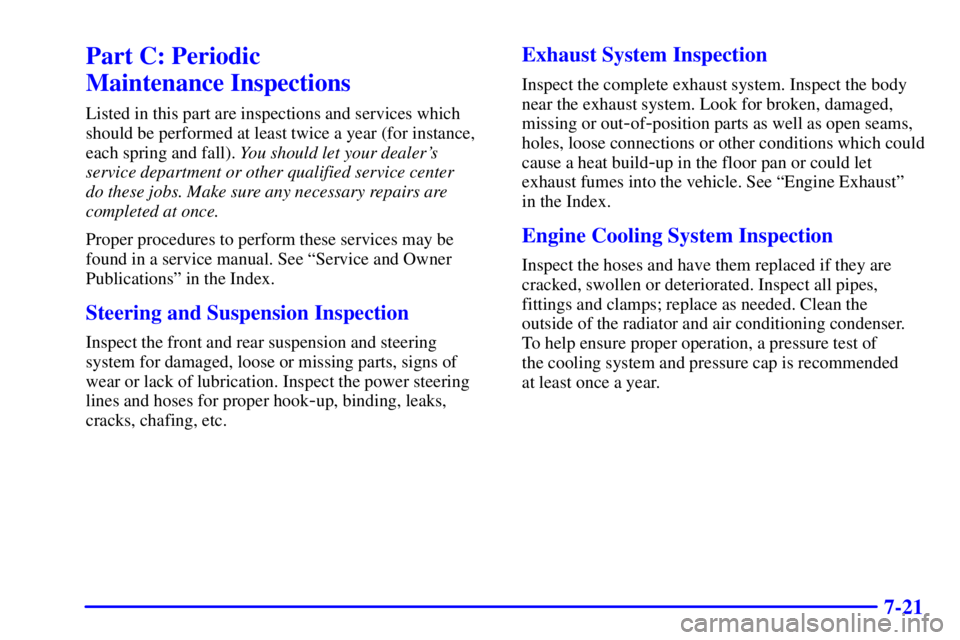Page 183 of 394

3-8 Air Conditioning
On hot days, open the windows long enough to let hot
air inside escape. This reduces the time it takes for your
vehicle to cool down. Then keep your windows closed
for the air conditioner to work its best.
The A/C button, below the mode knob, allows the
air coming into your vehicle to be cooled. This setting
is useful for normal cooling on hot days. When you
use A/C with the recirculation button pushed in,
turn off recirculation as soon as the vehicle reaches a
comfortable interior temperature.
Using A/C with the recirculation setting active
allows the air inside your vehicle to be recirculated.
This setting helps to maximize your air conditioner's
performance and your vehicle's fuel economy.
This setting also cools air the fastest and can be used
to keep unwanted odors and/or dust from entering the
vehicle. When using the air conditioner, turn off the
recirculation setting and use the outside air setting after
the vehicle reaches a comfortable interior temperature.
When the right knob on the control panel is between
heater and defrost, the recirculation feature will not
function to reduce window fogging.Passenger Compartment Air Filter
Your vehicle is equipped with a passenger compartment
air filter, which filters outside air entering the vehicle.
For information on replacing the filter see ªPassenger
Compartment Air Filterº in the Index.
Heating
The heater works best if you keep your windows closed
while using it. On cold days, use the heater or vent/heat
setting with the temperature knob in the red area.
On cold days, approximately 32�F (
-0�C) or
lower, you may experience differences in how
the transmission shifts until the engine is warm.
This feature automatically reduces the time it takes for
the engine to reach normal operating temperature and
shortens the time it takes the heater to reach full output.
If you use the engine coolant heater before starting
your engine in cold weather, 20�F (
-8�C) or lower,
the heating system will produce warmer air faster to heat
the passenger compartment.
The use of an engine coolant heater also reduces the
time it takes for the engine to reach normal operating
temperature. For more information, see ªEngine Coolant
Heaterº in the Index.
Page 185 of 394

3-10 Ventilation System
For mild outside temperatures when little heating or
cooling is needed, use outside air to direct outside air
through your vehicle. Air will flow through the
instrument panel outlets.
Your vehicle's ventilation system supplies outside air
to the inside of your vehicle when it is moving. With
the side windows closed, air will flow into the front air
inlet grilles, through the vehicle, and out the air
exhaust valves.
Outside air will also enter the vehicle when the heater or
the air conditioning fan is running, unless you have the
recirculation button pushed in. For more information on
the recirculation button, see ªAir Conditioningº earlier
in this section.
Your vehicle has air outlets
in the center and on the
sides of the instrument
panel and also may be
equipped on the headliner.
You can move the outlets from side
-to-side or up
and down to direct the flow of air. The left driver and
passenger outlets have shut off knobs. Turn the knob
to the left to shut off air flow or to the right to allow air
flow. When you close an outlet, it will increase the flow
of air coming out of any outlets that are open. The
center outlet does not completely shut off airflow.
Page 186 of 394

3-11
Ventilation Tips
�Keep the hood and front air inlet free of ice, snow or
any other obstruction (such as leaves). The heater
and defroster will work far better, reducing the
chance of fogging the inside of your windows.
�When you enter a vehicle in cold weather, turn the
fan knob all the way to the right for a few moments
before driving. This helps clear the intake ducts of
snow and moisture, and reduces the chance of
fogging the inside of your windows.
�Keep the air path under the front seats clear of
objects. This helps air to circulate throughout
your vehicle.
�The use of hood air deflectors may adversely
affect the performance of the heating and air
conditioning system.Audio Systems
Your audio system has been designed to operate easily
and give years of listening pleasure. You will get the
most enjoyment out of it if you acquaint yourself with it
first. Find out what your audio system can do and how
to operate all its controls, to be sure you're getting the
most out of the advanced engineering that went into it.
Your vehicle has a feature called Retained Accessory
Power (RAP). With RAP, you can play your audio
system even after the ignition is off. See ªRetained
Accessory Powerº in the Index.
Setting the Clock
Press and hold HR until the correct hour appears on the
display. Press and hold MN until the correct minute
appears on the display. To display the clock with the
ignition off, press RECALL or HR/MN and the time
will be displayed for a few seconds. There is an initial
two
-second delay before the clock goes into the
time
-set mode.
Page 353 of 394

6-65
Name Usage
O2 A Oxygen Sensors
O2 B Oxygen Sensors
LR PRK Left Rear Parking Lamps
RR DEFOG Rear Window Defogger,
Heated Mirrors
HDLP Headlamps (Relay)
TRL PRK Parking Lamps Trailer Wiring
PRIME Not Used
RT HDLP Right Headlamps
DRL Daytime Running Lamps (Relay)
HTD MIR Heated Mirrors
LT HDLP Left Headlamps
A/C Air Conditioning
AUX PWR Cigarette Lighter, Auxiliary
Power Outlets
SEO 2 Special Equipment Option Power,
Power Seats, Aux Roof Mnt Lamp
SEO 1 Special Equipment Option Power,
Aux Roof Mnt Lamp, Cell Phone
DRL Daytime Running Lamps
A/C A/C (Relay)
FOG LP Fog LampsName Usage
FOG LP Fog Lamps (Relay)
RADIO Audio System, Instrument Cluster,
Climate Control System
CIGAR Cigarette Lighter, Auxiliary
Power Outlets
RT TURN Right Turn Signals
BTSI Automatic Transmission Shift
Lock Control System
LT TURN Left Turn Signals
FR PRK Front Parking Lamps,
Sidemarker Lamps
W/W PMP Windshield Washer Pump
HORN Horn (Relay)
IGN C Ignition Switch, Fuel Pump,
PRND321 Display, Crank
RDO AMP Radio Amplifier
HAZ LP Exterior Lamps, Hazard Lamps
EXP LPS Not Used
HORN Horn
CTSY LP Interior Lamps
RR WPR Rear Wipers
TBC Body Control Module, Remote
Keyless Entry, Headlamps
Page 376 of 394

7-21
Part C: Periodic
Maintenance Inspections
Listed in this part are inspections and services which
should be performed at least twice a year (for instance,
each spring and fall). You should let your dealer's
service department or other qualified service center
do these jobs. Make sure any necessary repairs are
completed at once.
Proper procedures to perform these services may be
found in a service manual. See ªService and Owner
Publicationsº in the Index.
Steering and Suspension Inspection
Inspect the front and rear suspension and steering
system for damaged, loose or missing parts, signs of
wear or lack of lubrication. Inspect the power steering
lines and hoses for proper hook
-up, binding, leaks,
cracks, chafing, etc.
Exhaust System Inspection
Inspect the complete exhaust system. Inspect the body
near the exhaust system. Look for broken, damaged,
missing or out
-of-position parts as well as open seams,
holes, loose connections or other conditions which could
cause a heat build
-up in the floor pan or could let
exhaust fumes into the vehicle. See ªEngine Exhaustº
in the Index.
Engine Cooling System Inspection
Inspect the hoses and have them replaced if they are
cracked, swollen or deteriorated. Inspect all pipes,
fittings and clamps; replace as needed. Clean the
outside of the radiator and air conditioning condenser.
To help ensure proper operation, a pressure test of
the cooling system and pressure cap is recommended
at least once a year.